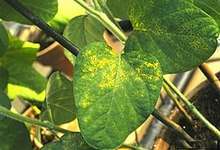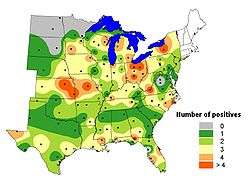Phakopsora pachyrhizi
| Phakopsora pachyrhizi | |
|---|---|
 | |
| Scientific classification | |
| Kingdom: | Fungi |
| Phylum: | Basidiomycota |
| Class: | Urediniomycetes |
| Subclass: | Incertae sedis |
| Order: | Uredinales |
| Family: | Phakopsoraceae |
| Genus: | Phakopsora |
| Species: | P. pachyrhizi |
| Binomial name | |
| Phakopsora pachyrhizi Syd. & P. Syd., (1914) | |
 | |
| Contour map showing numbers of NADP sites testing positive for P. pachyrhizi in center and East of USA in 2006. | |
| Synonyms | |
|
Malupa sojae | |
Phakopsora pachyrhizi is a plant pathogen. It causes Asian soybean rust.
Hosts
Phakopsora pachyrhizi is an obligate biotrophic pathogen that causes Asian soybean rust. Phakopsora pachyrhizi is able to affect up to 31 different plant species that belong to 17 different genera under natural conditions. Experiments in laboratories were able to use Phakopsora pachyrhizi to infect 60 more plant species.[1][2] The main hosts are Glycine max (soybean), Glycine soja (wild soybean), Pachyrhizus erosus (Jicama).
| Scientific name | Common name |
| Alysicarpus glumaceus | Alyce clover |
| Alysicarpus nummularifolius | |
| Alysicarpus rugosus | Alyce clover |
| Alysicarpus vaginalis | Alyce clover |
| Cajanus cajan * | Cajan, pigeon pea |
| Calopogonium mucunoides | |
| Canavalia gladiate | Swordbean |
| Centrosema pubescens | Butterfly pea |
| Clitoria termatea | Kordofan pea, butterfly pea, Asian pigeon wings |
| Coronilia varia | Crownvetch |
| Crotalaria anagyroides | Rattlebox |
| Crotalaria saltiana | Rattlebox |
| Crotaria spectabilis | |
| Delonix regia | Poinciana or royal Poinciana |
| Desmodium triflorum | Three-flowe beggarweed |
| Erythrina subumbrans | Dadap |
| Erythrina variegate | Indian coral tree |
| Glycine canescens | Soybean relative |
| Glycine clandestine | Soybean relative |
| Glycine clandestine | Soybean relative |
| Glycine falcadata | Soybean relative |
| Glycine max* | Soybean |
| Glycine soja | |
| Glycine tabacina | Soybean relative |
| Kennedia prostrata | |
| Kennedia rubicunda | |
| Lablab purpureus | Lablab, hyacinth bean |
| Lespedeza bicolor | Lespedeza |
| Lespedeza striata | Lespedeza |
| Lespedeza stipulaceae | Lespedeza |
| Lotus spp. | Trefoil |
| Lotus Americana | |
| Lupinus * | Lupines |
| Lupinus albus | White lupine |
| Lupinus angustifolius | Narrow-leaved lupine |
| Lupinus hirsutus | Blue lupine |
| Lupinus luteus | Yellow lupine |
| M. speciosus | |
| Macroptilium atropurpurem | Siratro, purple bean siratro |
| Macrotyloma axilare | |
| Medicago arborea | Medic |
| Medicago lupulina | Black medic |
| Melilotus officinalis | Yellow sweet clover |
| Mucuna | Velvetbeans |
| Mucuna cochinchinesis | Velvetbean relative |
| Neonotonia (glycine) wrightii | Glycine |
| Pachyrhizus ahipa * | Yam bean |
| Pachyrhizus erosus * | Yam bean, Jicama, chop suey bean |
| Phaseolus lunatus * | Buttler bean, lima bean |
| Phaseolus vulgaris * | Kidney bean, green bean |
| Pisum sativum | Peas (green) |
| Psophocarpus tetragonolobus | Winged bean or Goa |
| Pueraria lobate* | Kudzu |
| Puerarua montana var. Lobata* | Kudzu |
| Puerarua phaseoloides | Tropical kudzu |
| Rhynchosia minima | |
| Senna obtusifolia | Sickpod |
| Senna occidentalis | Coffee senna |
| Sesbania exaltada | Colorado River hemp, hemp sesbania, coffeebean |
| Sesbania macrocarpa | Peatree or Colorado River hemp |
| Sesbania vescaria | |
| Trifolium repens | White clover |
| Trifolium incarnatum | Crimson clover |
| Trigonella foenum-graicum | Fenugreek |
| Trigonella foenum-gracecum | Fenugreek |
| Vicia angustifolia | Narrow-leaf vetch |
| Vicia dasycarpa | Wooly-pod vetch |
| Vicia faba | Broadbean or fava bean |
| Vicia narbonensis | Broad-leaved vetch |
| Vicia villosa ssp. Varia | Woolypod vetch |
| Vigna mungo | Urd or black gram |
| Vigna radiate* | Mung bean |
| Vigna unguiculata* | Cowpea, black-eye pea, yearlong bean |
| Voandzeia subterranea | Bambara groundnut |
*preferred hosts. Other hosts were minor or determined experimentally under artificial conditions.
Symptoms
The disease froms tan to dark-brown or reddish-brown lesions with one to many prominent, globe-like orifices.[4] Urediniospores form from these pores.[5] At inicial stages small yellow spots are formed on the surface of the leaf. These spots may be better observed using assistance of a light source. As the disease progresses lesions starts to form on the leaves, stems, pod, and petioles. Lesions initially are small, turning from gray to tan or brown as they increase in size and the disease gets more severe. Soon volcano-shaped marks are noticed in the lesions.[6]
Disease cycle
Phakopsora pachyrhizi is a fungus which has a spore moved by wind, called Urediniospore. These spores are quite different from others as they don’t need an open stomata or natural openings in the leaves. Urediniospores are able penetrate the leave, pustules are visible after 10 days and they can produce spores for 3 weeks.[7] The disease reaches its climax when the crop begins flowering. The cycle of the pathogen continues until the crop is defoliated or until the environment becomes unfavorable to the pathogen.[8]

The Asian soybean rust is a polycyclic disease which within the disease cycle the asexual urediniospores are responsible to keep infecting the same plant. Teliospores (sexual spores) are the survival spores that overwinter in the soil. Basidiospores are the spores that are able to contaminate an alternative host. The urediniospores need a minimum of 6 hours to infect leaves at a favorable temperature (between 15-24 oC).[9]
Environment
The favorable conditions for the disease to progress are related to temperature, humidity, and wind. The appropriate temperature for the pathogen to be active is from the range of 12 to 29 oC (more efficient between 18-26.5 oC). Aside the temperature, the humidity must be really high about 90% or more for more than 12 hours. A significant amount of wind is also important for the pathogen to move from a plant to the other.[6][9] Current in the United States infected plant can be found in Florida, Georgia, Louisiana, and Texas.[2]
Risk factors
Uredospores are wind-blown and are produced abundantly on the infected tissue of soybeans or other legume hosts.[4]
Management
The disease is often controlled using the fungicides oxycarboxin, triforine, or triclopyr.[4]
Phakospsora pachyrhizi is a pathogen that acts quite fast in contaminating the host. The plant can be severely contaminated in a short period as 10 days. This makes difficult to control the disease, as it does not just spread quickly, but the progression of the disease is also fast. That's is why it is important to implement control techniques as soon as possible.
Genetic resistance
The disease may be controlled by using genetic resistance, but it has not exhibit great results it is not effective after a certain period.[6]
Chemical control
A second management that can work is using fungicides, but it is only efficient at early stages of the disease. The disease spreads fast and it is complicated to control after certain stages, so it is important to act careful around contaminated plants as the spores can be attached to clothing and other materials and infect other plants.[2]
References
- ↑ Goellner, Katharina; Loehrer, Marco; Langenbach, Caspar; Conrath, Uwe; Koch, Eckhard; Schaffrath, Ulrich (March 2010). "Phakopsora pachyrhizi, the causal agent of Asian soybean rust". Molecular Plant Pathology. 11 (2): 169–177. doi:10.1111/j.1364-3703.2009.00589.x. ISSN 1364-3703. PMID 20447267.
- 1 2 3 "details". www.tsusinvasives.org. Retrieved 2017-12-07.
- ↑ Coker, Hurst, Kirkpatrick, Rupe, Tingle, Trent, Cliff, Kim, Terry, John, Chris, Mark. "Asian Soybean Rust" (PDF).
- 1 2 3 Shanmugasundaram, S.; Yeh, C.C.; Hartman, G.L.; Talekar, N.S. (1991). Vegetable Soybean Research Needs for Production and Quality Improvement (PDF). Taipei: Asian Vegetable Research and Development Center. pp. 86–87. ISBN 9789290580478. Retrieved 6 February 2016.
- ↑ Sinclair, James Burton; Backman, P. A. (1989). Compendium of Soybean Diseases (3rd ed.). St Paul, MN: APS Press. ISBN 9780890540930.
- 1 2 3 Network, University of Nebraska-Lincoln | Web Developer (2015-09-18). "Asian Soybean Rust". CropWatch. Retrieved 2017-12-07.
- ↑ "Phakopsora pachyrhizi - Bugwoodwiki". wiki.bugwood.org. Retrieved 2017-12-07.
- ↑ "soybean rust, Phakopsora pachyrhizi N/A Uredinales: Phakopsoraceae". www.invasive.org. Retrieved 2017-12-07.
- 1 2 "Phakopsora pachyrhizi (soyabean rust)". www.cabi.org. Retrieved 2017-12-07.